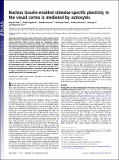Nucleus basalis-enabled stimulus-specific plasticity in the visual cortex is mediated by astrocytes
Author(s)
Chen, Naiyan; Sugihara, Hiroki; Sharma, Jitendra; Perea Parrilla, Gertrudis; Petravicz, Jeremy C.; Le, Chuong N.; Sur, Mriganka; ... Show more Show less
DownloadMriganka-2012-Nucleus basalis enabled stimulus specific.pdf (2.771Mb)
PUBLISHER_POLICY
Publisher Policy
Article is made available in accordance with the publisher's policy and may be subject to US copyright law. Please refer to the publisher's site for terms of use.
Terms of use
Metadata
Show full item recordAbstract
Although cholinergic innervation of the cortex by the nucleus basalis (NB) is known to modulate cortical neuronal responses and instruct cortical plasticity, little is known about the underlying cellular mechanisms. Using cell-attached recordings in vivo, we demonstrate that electrical stimulation of the NB, paired with visual stimulation, can induce significant potentiation of visual responses in excitatory neurons of the primary visual cortex in mice. We further show with in vivo two-photon calcium imaging, ex vivo calcium imaging, and whole-cell recordings that this pairing-induced potentiation is mediated by direct cholinergic activation of primary visual cortex astrocytes via muscarinic AChRs. The potentiation is absent in conditional inositol 1,4,5 trisphosphate receptor type 2 KO mice, which lack astrocyte calcium activation, and is stimulus-specific, because pairing NB stimulation with a specific visual orientation reveals a highly selective potentiation of responses to the paired orientation compared with unpaired orientations. Collectively, these findings reveal a unique and surprising role for astrocytes in NB-induced stimulus-specific plasticity in the cerebral cortex.
Date issued
2012-09Department
Massachusetts Institute of Technology. Computational and Systems Biology Program; Massachusetts Institute of Technology. Department of Brain and Cognitive Sciences; Picower Institute for Learning and MemoryJournal
Proceedings of the National Academy of Sciences of the United States of America
Publisher
National Academy of Sciences (U.S.)
Citation
Chen, N. et al. “Nucleus Basalis-enabled Stimulus-specific Plasticity in the Visual Cortex Is Mediated by Astrocytes.” Proceedings of the National Academy of Sciences 109.41 (2012): E2832–E2841. Web. © 2012 National Academy of Sciences.
Version: Final published version
ISSN
0027-8424
1091-6490